
Putrajaya, officially the Federal Territory of Putrajaya, is the administrative centre of Malaysia. The seat of the federal government of Malaysia was moved in 1999 from Kuala Lumpur to Putrajaya because of overcrowding and congestion, whilst the seat of the judiciary of Malaysia was later moved to Putrajaya in 2003. Kuala Lumpur remains as Malaysia's national capital city per the constitution and is still the seat of the head of state and the national legislature, as well as being the country's commercial and financial centre.

A cable-stayed bridge has one or more towers, from which cables support the bridge deck. A distinctive feature are the cables or stays, which run directly from the tower to the deck, normally forming a fan-like pattern or a series of parallel lines. This is in contrast to the modern suspension bridge, where the cables supporting the deck are suspended vertically from the main cable, anchored at both ends of the bridge and running between the towers. The cable-stayed bridge is optimal for spans longer than cantilever bridges and shorter than suspension bridges. This is the range within which cantilever bridges would rapidly grow heavier, and suspension bridge cabling would be more costly.

The Hungerford Bridge crosses the River Thames in London, and lies between Waterloo Bridge and Westminster Bridge. Owned by Network Rail Infrastructure Ltd it is a steel truss railway bridge flanked by two more recent, cable-stayed, pedestrian bridges that share the railway bridge's foundation piers, and which are named the Golden Jubilee Bridges.

The Puente de la Mujer is a rotating footbridge for Dock 3 of the Puerto Madero commercial district of Buenos Aires, Argentina. It is of the cantilever spar cable-stayed bridge type and is also a swing bridge, but somewhat unusual in its asymmetrical arrangement. It has a single mast with cables suspending a portion of the bridge which rotates 90 degrees in order to allow water traffic to pass. When it swings to allow watercraft passage, the far end comes to a resting point on a stabilizing pylon.

The Alamillo Bridge is a structure in Seville, Andalucia (Spain), which spans the Canal de Alfonso XIII, allowing access to La Cartuja, a peninsula located between the canal and the Guadalquivir River. The bridge was constructed as part of infrastructure improvements for Expo 92, which was held on large banana farms on the island. Construction of the bridge began in 1989 and was completed in 1992 from a design by Santiago Calatrava.

An inclined tower is a tower that was intentionally built at an incline. Towers are built with an incline in order to support the weight of another structure, such as the Montreal Tower. Some towers are built with an incline due to the steep terrain upon which they stand, or simply for aesthetics.

An extradosed bridge employs a structure that combines the main elements of both a prestressed box girder bridge and a cable-stayed bridge. The name comes from the word extrados, the exterior or upper curve of an arch, and refers to how the "stay cables" on an extradosed bridge are not considered as such in the design, but are instead treated as external prestressing tendons deviating upward from the deck. In this concept, they remain part of the main bridge superstructure.

The Seri Saujana Bridge is a main bridge in the planned city Putrajaya, the new (2001) Malaysian federal territory and administrative centre. The bridge's design is a unique combination of a symmetric cable-stayed structure and a through-arch bridge; the through-arch bridge portion is reminiscent of a slender version of the Sydney Harbour Bridge in Sydney, New South Wales, Australia.
Seri Setia Bridge is a main bridge in Putrajaya, Malaysia.

The Erasmusbrug is a combined cable-stayed and bascule bridge, construction began in 1986 and was completed in 1996. It crosses the Nieuwe Maas in the centre of Rotterdam, connecting the north and south parts of this city, second largest in the Netherlands. The bridge was named in 1992 after Desiderius Erasmus, a prominent Christian Renaissance humanist also known as Erasmus of Rotterdam. The Erasmus Bridge is Rotterdam's most important landmark and is even part of the city's official logo.

Perai River Bridge is a dual-three lane cable stayed bridge that straddles the Perai River in Seberang Perai, Penang, Malaysia. It is part of the Butterworth Outer Ring Road (BORR).

The Rama VIII Bridge is a cable-stayed bridge crossing the Chao Phraya River in Bangkok, Thailand. It was built to alleviate traffic congestion on the nearby Phra Pinklao Bridge. Construction of the bridge took place from 1999 to 2002. The bridge was opened on 7 May 2002 and inaugurated on 20 September, the birth anniversary of the late King Ananda Mahidol, after whom it is named. The bridge has an asymmetrical design, with a single pylon in an inverted Y shape on the west bank of the river. Its eighty-four cables are arranged in pairs on the side of the main span and in a single row on the other. The bridge has a main span of 300 metres (980 ft), and was one of the world's largest asymmetrical cable-stayed bridges at the time of its completion.

The Octavio Frias de Oliveira bridge, locally known simply as "Ponte Estaiada", is a cable-stayed bridge over the Pinheiros River in the city of São Paulo, Brazil, opened in May 2008. The iconic bridge has an "X"-shaped tower, 138 metres (453 ft) tall, and connects the west end of Jornalista Roberto Marinho Avenue to the riverside expressway Marginal Pinheiros in the south area of the city. It is named after businessman Octavio Frias de Oliveira.

Langkawi Sky Bridge is a 125-metre (410 ft) curved pedestrian cable-stayed bridge in Malaysia, completed in 2005. The bridge deck is 660 metres (2,170 ft) above sea level at the peak of Gunung Mat Cincang on Pulau Langkawi, the main island of the Langkawi archipelago in Kedah. The Langkawi Sky Bridge can be reached by first taking the Langkawi Cable Car to the Top Station, where an inclined lift called SkyGlide takes visitors from the Top Station down to the bridge.

The Russky Bridge is a cable-stayed bridge in Vladivostok, Primorsky Krai, Russia. The bridge connects the Russky Island and the Muravyov-Amursky Peninsula sections of the city across the Eastern Bosphorus strait, and with a central span of 1,104 metres, it is the longest cable-stayed bridge in the world. The architect of the Russky Island Bridge is Vlydskinol Ptrov. The Russky Bridge was originally built to serve the 2012 Asia-Pacific Economic Cooperation conference hosted at the Far Eastern Federal University campus on Russky Island. It was completed in July 2012 and opened by Prime Minister Dmitry Medvedev, and on September 3, 2012, the bridge was officially given its name.

Vidyasagar Setu, also known as the Second Hooghly Bridge, is an 822.96-metre-long (2,700 ft) cable-stayed six-laned toll bridge over the Hooghly River in West Bengal, India, linking the cities of Kolkata and Howrah. Opened in 1992, Vidyasagar Setu was the first and longest cable-stayed bridge in India at the time of its inauguration. It was the second bridge to be built across the Hooghly River in Kolkata metropolitan region and was named after the education reformer Pandit Ishwar Chandra Vidyasagar. The project had a cost of ₹388 crore to build. The project was a joint effort between the public and private sectors, under the control of the Hooghly River Bridge Commissioners (HRBC).

The Assut de l'Or Bridge is a white single-pylon cable-stayed bridge in the City of Arts and Sciences in Valencia, Spain, designed by Valencian architect and civil engineer Santiago Calatrava and completed in December 2008. The name l'Assut de l'Or is Valencian for the Dam of the Gold and refers to a dam that was located nearby. Calatrava called it the Serreria Bridge.

The Captain William Moore Bridge is an historic 300-foot (91 m) asymmetric single-pylon cable-stayed bridge on the Klondike Highway that spans the Moore Creek Gorge in the borough of Skagway, Alaska, United States, about 17 miles (27 km) north of the city of Skagway. Before the bridge was built in 1976, Whitehorse, Yukon, was only accessible from Skagway by the White Pass and Yukon Route railroad. The bridge connects Skagway to the Yukon highway network and allows traffic to pass over the Moore Creek Gorge, which flows along a fault line. To minimize bridge damage from earthquake movements along the fault line, the bridge was designed with anchors only at one end, which in this case was the south bank. Over the decades, heavy ore truck traffic weakened the bridge. In 2019 a replacement buried bridge located 150 feet west of the historic bridge was opened, and the 1976 cable-stayed bridge was repurposed as a pedestrian viewpoint and wayside historic attraction.
It's historic and beautiful, and is the only cantilevered cable-stayed bridge in Alaska...

The Signature Bridge is a cantilever spar cable-stayed bridge which spans the Yamuna river at Shourya section, connecting Wazirabad to East Delhi. It is India's first asymmetrical cable-stayed bridge. The pylon of the Signature bridge is the tallest structure in Delhi and is double the height of Qutub Minar with its 154-metre high viewing box, which is a location where visitors take selfies. It shortens the travel time between north and northeast Delhi.






















